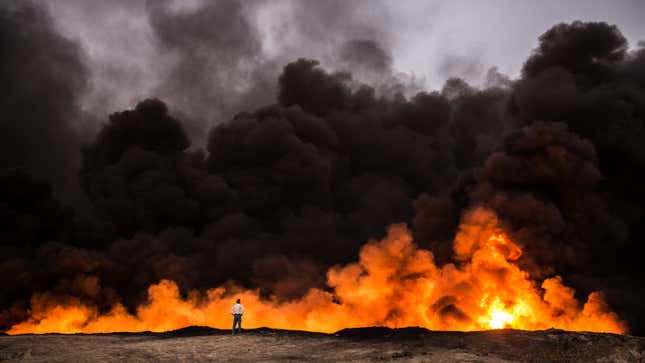
A year ago today, oil prices did something never before seen: They dipped into negative territory, meaning suppliers were literally paying people to take the oil off their hands.
It was a shocking moment in a year full of them, as the pandemic drove down demand for the fossil fuels that the world runs on. A year later, oil demand is back, and the world is headed for the second-largest surge in year-over-year carbon pollution ever seen. It’s reflective of the stark reality that, for all that has changed over the past year, we’re still living in a world controlled by fossil fuel interests. But if world leaders squandered a prime moment to intervene in reshaping our relationship with fossil fuels last year, the chance is still there to do the right thing for the climate and workers now.
Oil sat at around $63 per barrel on Wednesday, an almost exactly $100 difference from where it was at this time last year. Demand is bouncing back as vaccination campaigns—at least in many wealthy parts of the world—pick up speed and coronavirus travel restrictions and concerns begin to relax further. In that light, it’s easy to see last year’s nadir for the industry, when bankruptcies, losses, exploration for new oil, and demand all tanked, as a missed opportunity to rein in the industry. But the next best moment is right now.
The hegemony of oil and gas, not just in the U.S. but globally, is on clear display in a new International Energy Agency report out this week showing the world is poised for the second-largest increase in carbon dioxide emissions ever.
“This is shocking and very disturbing,” Faith Birol, the IEA chief, told the Guardian. “On the one hand, governments today are saying climate change is their priority. But on the other hand, we are seeing the second biggest emissions rise in history. It is really disappointing.”
Disturbing, yes. But shocking, it is not. The world’s energy system before the pandemic ran on fossil fuels. And while demand cratered last year, governments failed to adequately address the structural issues with how the economy runs.
“We have indeed failed to date to really decouple economic activity and CO2 emissions, and that’s precisely what we’re seeing,” Mark Paul, an economist at the New College of Florida, said. “What what we really need to focus on, in my opinion, is the twofold mission of building out the green economy that we need, which requires major public investments, and dismantling the existing fossil fuel infrastructure.”
To that end, some work is in its nascent stages, particularly with the changing of the presidential guard in the U.S. The Biden administration has signed a $2.3 trillion coronavirus relief package into law, put a big (but not big enough) infrastructure proposal out there to do more green building, and inked a few pro-climate executive orders linking reducing emissions with improving the economy. A slew of new bills in the Democratic-controlled Congress also point to a path forward to link economic well-being, labor protections, and mitigating climate change. And unions, including the largest coal mining union in the U.S., also appear to be lining up for a transition away from fossil fuels. This type of coalition, one that centers fossil fuel workers, is absolutely crucial to ensuring that policies to wind down the fossil fuel industry have buy-in and muscle to battle the titans of industry themselves.
Seeing oil prices swing back up and the projected huge rise in carbon dioxide emissions in 2021 is a sign of how much remains to be done and how powerful the industry remains. Recent revelations of oil companies raking in government funds or paying off shareholders while laying off workers are a reminder they will fight to the end to make money for a select few at the expense of the climate and the very workers that make them profitable.
“The single best thing that the administration could do to wind down the existing fossil fuel infrastructure—and do it in a planned way that really minimizes the negative impact both on communities dependent on fossil fuel jobs and on the workers dependent on those jobs for their livelihoods—is to nationalize the fossil fuel industry and engage in a managed phase-out,” Paul said. “The administration needs to put these workers at the top of their priority list, and that means investing in communities and providing them alternative pathways to middle-class jobs and secure livelihoods that don’t include extracting fossil fuels from the Earth. The worst thing that we could do right now is to leave fossil fuel workers and their communities high and dry.”
What may sound radical has been done before, with Paul noting former President George W. Bush essentially nationalized airport security with the creation of the Transportation Security Administration in the wake of 9/11. In the case of the fossil fuel industry, the government wouldn’t be stepping in to supposedly try to do something better—in this case, the extraction of fossil fuels. Instead, it would be ending the practice of doing something harmful for the planet and doing so in a way that supports workers.
We’re at a moment where radical change is needed, and the window to pursue those changes is still cracked opened just a smidge. If Biden and other world leaders fail to bound through it, this year’s hike in carbon emissions could be an ominous preview of what’s to come.